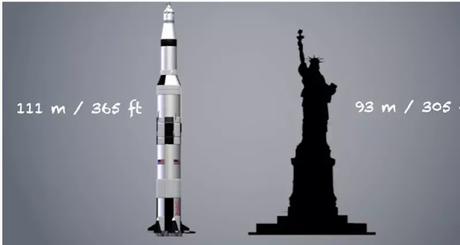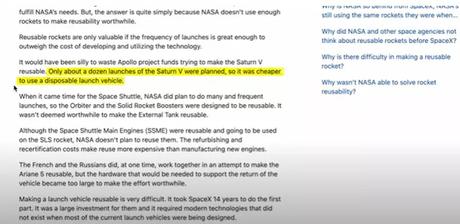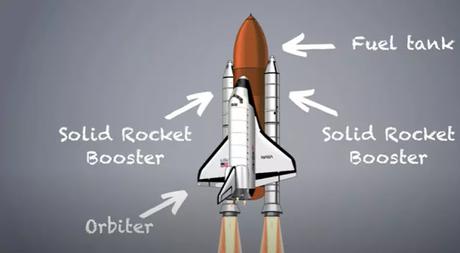For decades, reusable rockets were commonplace in science fiction. But they only became a reality in 2015, when SpaceX landed the first stage of its Falcon 9 for the first time. NASA never tried to do anything like what SpaceX is doing.
The closest NASA ever got to anything like it was the semi-reusable Space Shuttle. So, why doesn’t NASA fly reusable rockets? To answer this question, we need to go back to the 1960s when NASA designed the Saturn V and hired contractors to build it.

This monster rocket sent astronauts to the moon as part of the Apollo program. Fully fueled, it weighed over six million pounds or about the same as 400 elephants and stood taller than the Statue of Liberty. The Saturn V was not at all reusable.
The first two stages would fall into the ocean. The third blasted the astronauts to the lunar surface and would either remain in space or crash into the moon. I doubt it ever occurred to the people designing the big F1 engines that you could make something that big reusable. And at that point in the evolution of the space program, we don’t think reusability was a consideration.
The government agency was instead focused on landing the first-ever crew on the moon. A NASA employee also pointed to another reason the Saturn V was expendable. A flight operations directorate named Robert Frost explained that only about a dozen launches of the Saturn V were planned, so it was cheaper to use a disposable launch vehicle.

In the end, the Saturn V ended up being very expensive - costing $185 million for every launch. That’s about $1.3 billion today adjusted for inflation. NASA was so burdened financially that potential plans to produce more than the initial 15 Saturn Vs had to be scrapped. Then and only then did the agency consider reusable rockets.
Senior NASA administrator George Mueller championed the development of a fully reusable system. But the Space Shuttle never became quite what he envisioned. The engineers found out that it was too expensive and too technically challenging to make it fully reusable. They settled on making it partially reusable.

The orbiter that housed the crew could bere-used. So could the two Solid Rocket Boosters. But not the large external tank that held the fuel for the main engines - that would burn up in Earth’s atmosphere. Despite its partial reusability, the Shuttlefailed to lower costs. NASA pegged the price of a launch at $450million.
However, several independent sources estimated that the actual cost was around $1.3 - $1.5 billion - in the same ballpark as the Saturn V while carrying less payload- making it more expensive on a per-pound basis.
One reason is that the Space Shuttle required a lot of work to prep for another mission. For example, 21,000 thermal protection tiles needed to be inspected. The boosters had to be fished out of the ocean to be refurbished.
So, it became difficult and costly to turn around the Space Shuttle quickly. Plus, the production facility that churned out the external fuel tanks could only manage a maximum of 24 a year. The Space Shuttle would only end up flying an annual average of 4 times annually anyway. Tragedies like the Challenger disaster also halted the program for years.
NASA never achieved the rapid reusability characteristic of private companies like SpaceX which hopes spaceflight will one day be as routine as plane travel. That is a difficult feat. It took SpaceX 13 years to successfully land the first stage. Unlike NASA, SpaceX started out with a vision of building reusable rockets and stuck with it. Others are also banking on reusability. Blue Origin’s New Glenn will be designed with a reusable booster.
ULA is considering catching the Vulcan Centaur’s two engines mid-air. China is developing the Long March 8 to land its first stage. Despite the technological advancements in rocketry, NASA’s upcoming replacement for the retired Space Shuttle is still not reusable.
The Space Launch System is intended to carry heavy payloads to the moon and maybe one day, Mars. The core stage is being built by Boeing but the rocket is also using some of the same hardware from the Space Shuttle. And will actually discard the RS-25 engines that the Shuttle did re-use.
So why not make the SLS reusable? NASA says it’s to bring down costs and speed up development time. Because again, it’s not going to be used very often. Going to the additional engineering, the additional cost of designing something that big to be reusable compared to how infrequently it's going to be used, I think the cost trade-off is in favor of expandability.
It may only take off once a year whereas the commercial sector could be the one organizing regular trips to space in the future. Headlines have questioned whether the SLS is even worth the expected $2 billion dollar price tag per launch.

Especially since SpaceX is building the giant, fully reusable Starship. Musk has said that in time, each launch of Starship will only be about $2 million - or 0.1% of the cost of the SLS though without NASA, there would likely be no SpaceX.
Also Read: NASA |4 Tiny Missions Answering the Biggest Questions in Astrophysics
The agency handed out billion-dollar launch contracts that kept the company afloat. Plus, the purpose of NASA is to do the research that private companies don’t do or won’t do. As the private space industry grows, NASA may never feel the need to develop anything fully reusable. The SLS is expected to take off in late 2021 at the earliest.

